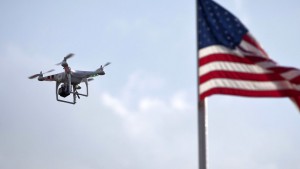
You need a license for that.
Or, at the very least, you need a registration. Many drone operators don’t realize that in order to operate a drone commercially, special licensing from the FAA is required. If you are making money from your drone in any way – taking pictures of real estate, or selling aerial images to local businesses – the law currently requires that you have a Section 333 Exemption.
The good news is that the rules are changing – as of August 29, you’ll need the much simpler Part 107 “remote pilot airman certificate with a small UAS rating,” to fly commercially. A Part 107 certificate may be easier to obtain than a Section 333 Exemption, but it still requires that you pass an aeronautical knowledge test at a specified FAA testing center.
Just using your drone for fun? The law says you must register your drone with the FAA, and write your registration number on the drone. While the process only takes a few minutes – and costs $5 – registering your drone will give you access to current regulations and keep you on the right side of the law.
Stay Away from Airports – Unless You Have Permission
Unless you have notified the local airport that you plan to fly, you must stay 5 miles away from airports. This rule may be commonly broken, as some drone operators don’t realize that they are within a five mile radius of a smaller regional airport. But as pilots report more sightings of “rogue drones” the FAA is ramping up enforcement and mitigation efforts. Drone operators who disregard the 5 mile radius could be fined or have their drone confiscated.
Bonus: Don’t fly over prisons, water towers, power plants, or anything else that might be labeled a “sensitive facility.”
Limit Your Altitude
Recreational drones and most commercial drones are expected to fly under 400 feet, and stay below nearby obstacles. This may be lower than your drone can fly, but by keeping your flight low you will avoid the possibility of being accused of endangering a passenger aircraft.
Don’t worry that you won’t be able to get great shots from that height. 400 feet is very, very high – the Statue of Liberty including it’s base is 305 feet.
Observe “No Fly” Zones
Don’t worry – there are apps to help you stay informed and avoid prohibited areas. DJI’s new GO app with geofencing keeps you updated on current no fly zones and keeps your drone from flying into one accidentally; and the FAA has worked with industry on the B4UFly App to identify no drone zones.
Don’t Fly Over People
In part, this is just good manners – but it’s also the law. “Do not intentionally fly over unprotected persons or moving vehicles,” says the Know Before You Fly website, “and remain at least 25 feet away from individuals and vulnerable property.”
Flying over people without their permission may cause a nervous neighbor to report you and your drone – or do something dramatic, like the man in Kentucky who shot down a drone flying over his property. Avoid problems by keeping your drone in an open space.
Know Your State and Local Regulations
While the FAA has made the federal drone regulations for recreational use clear, many states and local governments have added another layer of regulation. Before you fly – especially if you live in an urban area – you should check with your local government to ensure that there aren’t more regulations to follow. The National Conference of State Legislators (NCSL) has a useful website that lists current state drone regulations. According to the NCSL, 32 states have passed drone laws and 5 more have passed resolutions pertaining to drone use.
You can find more detailed information on drone regulations – there are more than the top 5 – at the FAA website, the Know Before You Fly website, or by registering your drone. As more people fly drones for fun or get involved in drone sports like drone racing or drone battles, the industry is growing and more venues and events appear. If recreational drone users follow the basic rules, the public may become less nervous about the potential risk of drones and more enthusiastic about the many benefits that drones have to offer.
Miriam McNabb is the Editor-in-Chief of DRONELIFE and CEO of JobForDrones, a professional drone services marketplace, and a fascinated observer of the emerging drone industry and the regulatory environment for drones. Miriam has penned over 3,000 articles focused on the commercial drone space and is an international speaker and recognized figure in the industry. Miriam has a degree from the University of Chicago and over 20 years of experience in high tech sales and marketing for new technologies.
For drone industry consulting or writing, Email Miriam.
TWITTER:@spaldingbarker
Subscribe to DroneLife here.